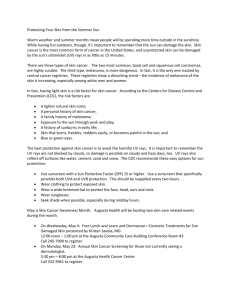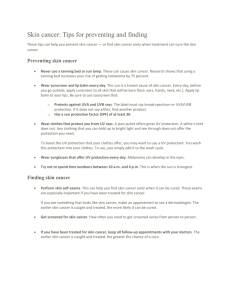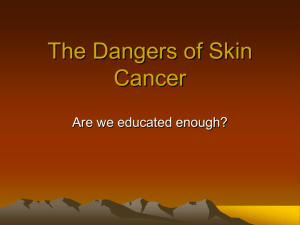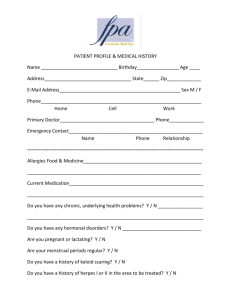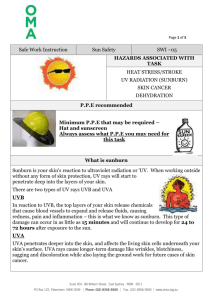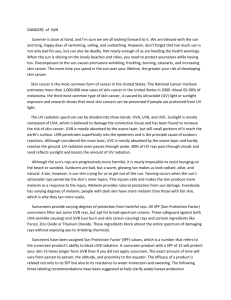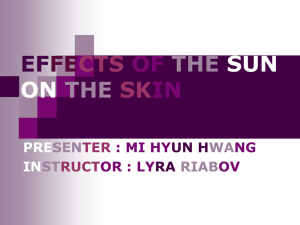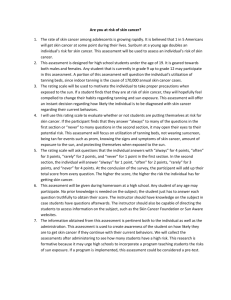Compiled Sun Info
advertisement
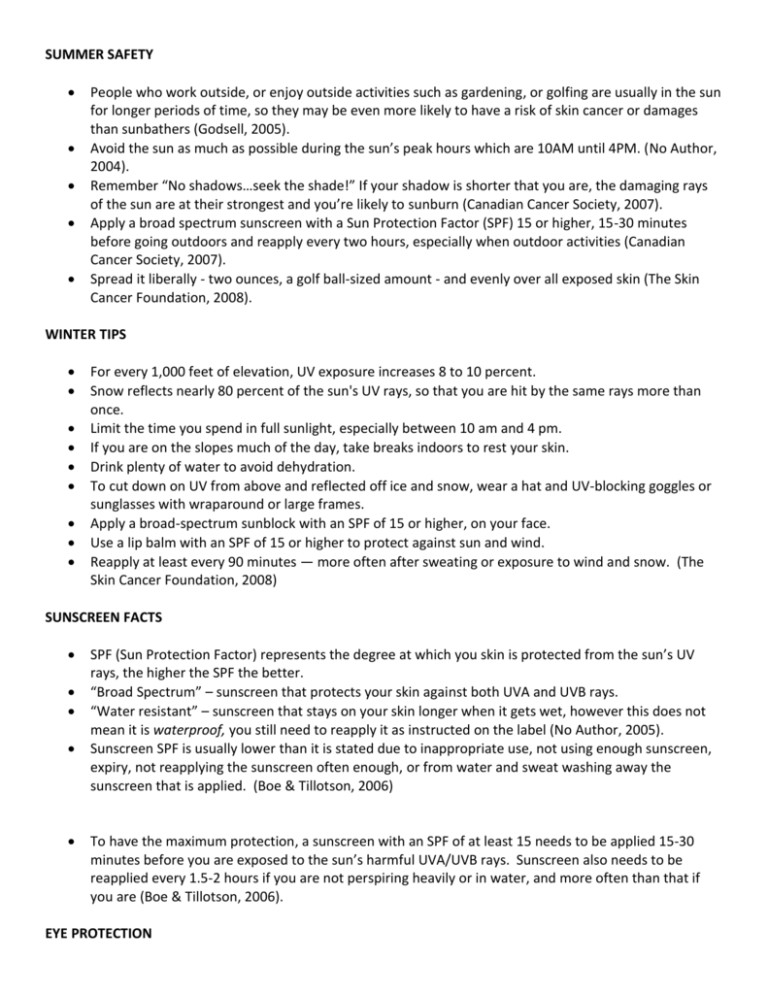
SUMMER SAFETY People who work outside, or enjoy outside activities such as gardening, or golfing are usually in the sun for longer periods of time, so they may be even more likely to have a risk of skin cancer or damages than sunbathers (Godsell, 2005). Avoid the sun as much as possible during the sun’s peak hours which are 10AM until 4PM. (No Author, 2004). Remember “No shadows…seek the shade!” If your shadow is shorter that you are, the damaging rays of the sun are at their strongest and you’re likely to sunburn (Canadian Cancer Society, 2007). Apply a broad spectrum sunscreen with a Sun Protection Factor (SPF) 15 or higher, 15-30 minutes before going outdoors and reapply every two hours, especially when outdoor activities (Canadian Cancer Society, 2007). Spread it liberally - two ounces, a golf ball-sized amount - and evenly over all exposed skin (The Skin Cancer Foundation, 2008). WINTER TIPS For every 1,000 feet of elevation, UV exposure increases 8 to 10 percent. Snow reflects nearly 80 percent of the sun's UV rays, so that you are hit by the same rays more than once. Limit the time you spend in full sunlight, especially between 10 am and 4 pm. If you are on the slopes much of the day, take breaks indoors to rest your skin. Drink plenty of water to avoid dehydration. To cut down on UV from above and reflected off ice and snow, wear a hat and UV-blocking goggles or sunglasses with wraparound or large frames. Apply a broad-spectrum sunblock with an SPF of 15 or higher, on your face. Use a lip balm with an SPF of 15 or higher to protect against sun and wind. Reapply at least every 90 minutes — more often after sweating or exposure to wind and snow. (The Skin Cancer Foundation, 2008) SUNSCREEN FACTS SPF (Sun Protection Factor) represents the degree at which you skin is protected from the sun’s UV rays, the higher the SPF the better. “Broad Spectrum” – sunscreen that protects your skin against both UVA and UVB rays. “Water resistant” – sunscreen that stays on your skin longer when it gets wet, however this does not mean it is waterproof, you still need to reapply it as instructed on the label (No Author, 2005). Sunscreen SPF is usually lower than it is stated due to inappropriate use, not using enough sunscreen, expiry, not reapplying the sunscreen often enough, or from water and sweat washing away the sunscreen that is applied. (Boe & Tillotson, 2006) To have the maximum protection, a sunscreen with an SPF of at least 15 needs to be applied 15-30 minutes before you are exposed to the sun’s harmful UVA/UVB rays. Sunscreen also needs to be reapplied every 1.5-2 hours if you are not perspiring heavily or in water, and more often than that if you are (Boe & Tillotson, 2006). EYE PROTECTION UV exposure contributes to several serious eye disorders, including cataracts and macular degeneration. (The Skin Cancer Foundation, 2008) Most cancers of the eye occur in the lower eyelid skin Wearing sunglasses from an early age can help to block out UV lights and protect your eyes from harm. (Watch Your Eyes, 2000). Sunglasses should block against 99-100% of UVA and UVB radiation (No Author, 2005). SUN SAFE CLOTHING Wear protective clothing, including a wide-brimmed hat, sunglasses and long-sleeved shirt and pants during prolonged periods of sun exposure (Canadian Cancer Society, 2007). A 4 inch brimmed hat reduces sun exposure by 70% to head neck and face Dark colors and thicker fabrics help prevent the UV rays from reaching your skin. When your clothing gets wet it also loses any ability to protect you from the sun’s UV rays (Boe & Tillotson, 2006). Wet clothing allows about 50% transmission of UV radiation (No Author, 2005). UV INFO There are 3 types of UV rays: Ultraviolet A rays (UVA) make up most of the sun’s natural light. They can penetrate deep into the skin causing wrinkles and aging. Ultraviolet B rays (UVB) are the most damaging to our skin. They are the main cause of sunburns as they are nearly 1000 times stronger than UVA rays. Ultraviolet C rays (short-wave radiation) never reach the earth’s surface because the atmosphere filters them out (Canadian Cancer Society, 2007). Amount of UV rays that reach the earth depends on: Time of day - strongest rays from 10am - 4pm Season - the sun’s rays hit Canada most directly in the summer time. Altitude - UV radiation increases 8-10% for every 1000 ft. of elevation Cloud Cover - even a thin cover reduces UV radiation by 20-40% Reflection - sand and concrete reflect 25% of the rays, while water reflects nearly 100% and snow reflects 80% (No Author, 2005). TANNING BED TRUTH Greater than one million Americans go to artificial tanning salons every day, the majority of the people who attend these tanning booths as Caucasian girls ages 16 – 45. In 1994, 16% of teenage males, and 33% of teenage females used tanning beds, and has increased since then (Murray, C., & Turner, E., 2004). Women who use tanning salons more than once a month are 55% more likely to have malignant melanoma (Jarvis, C., 2008). Unfortunately, 55% of people who use tanning beds strongly agree they received a lack of information about the use/risks of sun beds (Murray, C., & Turner, E., 2004). Tanning salons may argue that “controlled” tanning helps prevent melanoma by building up the productive pigment melanin. This is wrong. Tanning, like burning, causes genetic damage to skin cells (No Author, 2007). There are many adverse effects of tanning beds, including acute sunburn, suppression of DNA repair and immune functioning, ocular disorder, and increased risk of skin cancer (Jarvis, 2008). Regardless of the increased knowledge of the harmful effects of tanning, the popularity of indoor tanning is still increasing in numbers, especially among teens The International Agency for Research on Cancer (IARC), a branch of the World Health Organization (WHO), has linked sunbed tanning among young people to melanoma, the deadliest form of skin cancer. This link is disturbing— it shows a 75 percent increase in risk of melanoma among those who first used sunbeds in their twenties or teen years (Skin Cancer Foundation, 2008). You are at a higher risk of skin damage from using indoor tanning beds and lamps if: You have had skin cancer You are under 18 You are fair skinned, have freckles or moles There is s a family history of skin cancer You are using medications that increase your sensitivity to UV including the birth control pill. MELANOMA DATA Melanoma is the most serious form of skin cancer Can develop from or near a mole 75% from all skin cancer deaths are due to Melanoma Excessive exposure to the sun is the most preventable cause of melanoma. Caucasians are 10x more likely to be diagnosed In 2003, there were approximately 91,900 new cases of melanoma. This is a 4 percent increase in new cases of melanoma from 2002 (Canadian Cancer Society, 2007). Melanoma is more common than any non-skin cancer among women between 25 and 29 years old (Canadian Cancer Society, 2007). Melanoma causes approximately 8000 deaths per year (Skin Cancer Prevention, 2006). With early detection, melanoma has a cure rate of 95% (American Academy of Dermatology, 2007). SELF EXAM Check your skin, once a year (on your birthday) for any irregularities. Secret areas melanoma may start include under the nails, the scalp, soles of the feet and palms of the hands. Know your ABCDE’s: Assymmetry, Border, Color, Diameter, Elevation A mole meeting one or two of the ABCDE’s is probably nothing to be concerned about and you should simply continue to monitor it for any further changes. A mole meeting several of these criteria, especially one that has changed recently should be further examined by a doctor POST-SECONDARY SURVEY SAYS…
